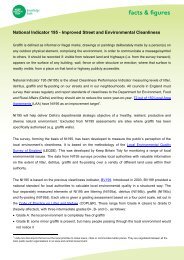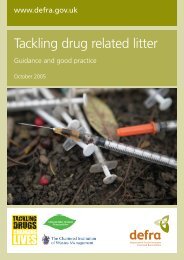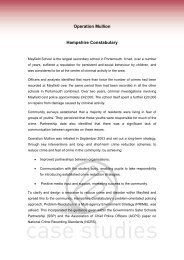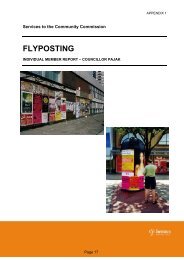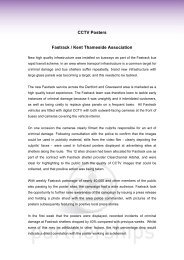a guide to improving your local environment - Keep Britain Tidy
a guide to improving your local environment - Keep Britain Tidy
a guide to improving your local environment - Keep Britain Tidy
Create successful ePaper yourself
Turn your PDF publications into a flip-book with our unique Google optimized e-Paper software.
CHEWING GUM LITTER<br />
www.encams.org<br />
What’s the extent of the gum problem<br />
In the UK 20 million people consume more than 935<br />
million packets of gum a year. Just under half of the UK<br />
population chew gum, and the market, currently valued at<br />
£322m, is constantly growing.<br />
Whilst many people dispose of their gum correctly, there<br />
are some who drop or spit it out on<strong>to</strong> the streets. Once<br />
trodden in, gum can be extremely difficult and costly <strong>to</strong><br />
remove, causing staining <strong>to</strong> paved areas.<br />
What are the gum dropping laws<br />
Dropping gum is classed as dropping litter. This is made<br />
explicit in s.27 CNEA 2005. Therefore the same laws and<br />
penalties as outlined above for dropping litter apply <strong>to</strong><br />
dropping gum. Many councils have taken action against<br />
gum droppers, issuing Fixed Penalty Notices for<br />
littering offences.<br />
Once gum becomes flattened <strong>to</strong> the surface of a<br />
pavement it can’t be removed as you would a<br />
piece of litter.<br />
GUM LITTER<br />
Is chewing gum litter/staining a problem<br />
Chewing gum litter and the staining it causes pose a<br />
problem in many different ways.<br />
Chewing gum is the most prevalent form of staining<br />
In a survey of over 10,000 sites falling within a range of<br />
different land uses, ENCAMS found solid gum present at<br />
3% of sites and staining resulting from people dropping<br />
or spitting gum at 55%. The amount of impacted gum<br />
recorded during the survey has declined over the last<br />
three years. However, it is still the biggest form of<br />
staining with accumulations becoming extreme in<br />
locations where people congregate including main <strong>to</strong>wn<br />
and city centres (91%), <strong>local</strong> retail and commercial areas<br />
(84%) and bus and railway stations (60%).<br />
17




